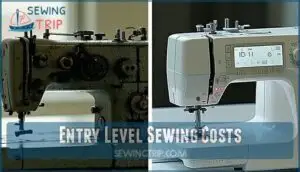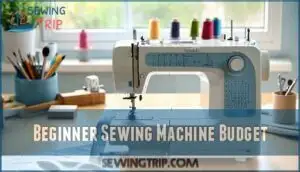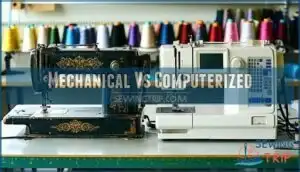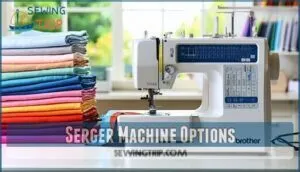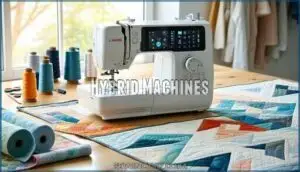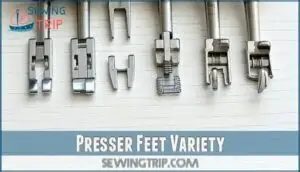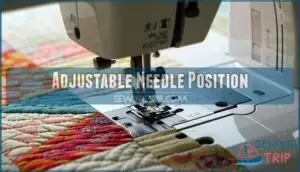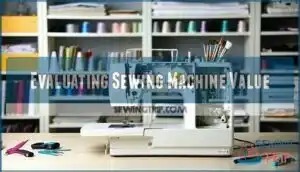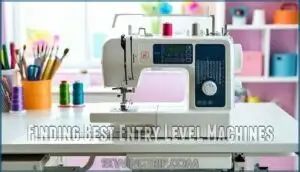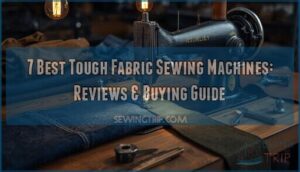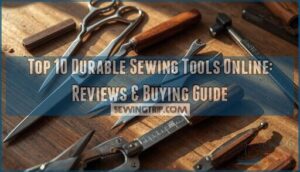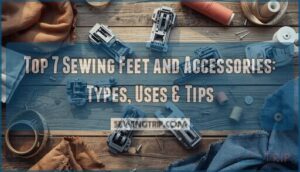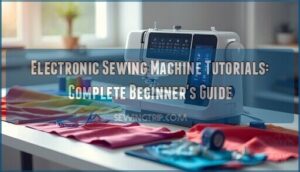This site is supported by our readers. We may earn a commission, at no cost to you, if you purchase through links.
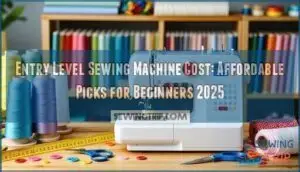
Mechanical models start around $100-$150, while basic computerized options begin at $150-$300.
You’re paying for essential features like straight stitching, zigzag capabilities, and automatic buttonholes.
Brands like Singer, Brother, and Janome offer reliable starter machines that won’t break the bank.
When shopping, consider the machine’s weight (lighter isn’t always better), noise level, and included accessories.
Remember, the cheapest option isn’t always the most economical in the long run—durability matters when you’re learning to navigate the threading maze.
Table Of Contents
Key Takeaways
- You’ll typically spend $100-$300 for a quality entry-level sewing machine, with mechanical models starting around $100-$150 and basic computerized options beginning at $150-$300.
- Your money buys essential features like straight stitching, zigzag capabilities, and automatic buttonholes, with brands like Brother, Singer, and Janome offering reliable starter machines.
- You should prioritize features that simplify learning, such as automatic threaders, varied presser feet, and adjustable needle positioning rather than focusing on the cheapest option available.
- You’ll need to consider long-term value factors beyond initial price, including warranty coverage (typically 1-3 years), maintenance costs ($100-$500 annually), and local repair service availability.
Entry Level Sewing Costs
When starting with an entry-level sewing machine, it’s important to understand how pricing varies between mechanical and computerized models.
Mechanical machines are usually more affordable, while computerized options offer advanced features at a higher cost, but both can suit beginner needs within a reasonable budget.
Mechanical Machine Prices
Mechanical sewing machines are a great entry-level option, with prices starting from $129.99.
Their simplicity guarantees easy repairs, durability, and long-term value.
These machines are available on mechanical sewing machines.
Consider these factors:
- Durability Factors: Built to last.
- Basic Features: Perfect for beginners.
- Repair Costs: Lower than computerized models.
- Used Machines: Save money, starting at $50.
- Affordable Sewing Machine Choices: Reliable at $150 or less.
Computerized Machine Prices
When exploring computerized sewing machine prices, you’ll find ranges as low as $150 under sales and discounts, up to $4,495 for advanced models.
Feature influence and brand pricing play key roles in sewing machine cost.
For beginners, a sewing machine under $300 offers long-term value.
Metal frames offer enhanced overall durability.
Consider repair costs alongside upfront savings when evaluating your ideal choice.
Budget Friendly Options
If you’re hunting for an entry level sewing machine, options like used machines or DIY kits can save you money.
Rental options or shared resources also help beginners explore without commitment.
Watch for discount events or brands offering sewing machines under 200 dollars. A cheap sewing machine doesn’t mean compromise—just smart choices that match your needs.
Beginner Sewing Machine Budget
When setting a budget for a beginner sewing machine, you’ll want to weigh factors like price range, durability, and included features.
Understanding what you’re paying for guarantees you get a machine that balances affordability with the essentials needed for an enjoyable learning experience.
Factors Affecting Cost
When comparing sewing machine prices, material costs, labor costs, and production scale substantially affect sewing machine cost.
Feature complexity, like automatic threaders or adjustable needle positions, adds value but increases your sewing machine budget.
Brand reputation matters, too—trusted names often produce reliable, entry-level sewing machines at reasonable prices.
A cheap sewing machine balances features and durability within your budget, considering the brand reputation.
Brand Comparison
In the context of sewing machine brands, Brother vs Singer often highlights affordability and ease, while Janome vs Pfaff emphasizes durability and advanced features.
Brother excels in budget-friendly options, like the CS7000X, ideal for beginners.
Janome and Pfaff lean in the direction of reliability with premium designs, and it is crucial to prioritize feature availability and price differences to find a sewing machine that balances quality with your budget.
Many consumers directly compare product offerings before making a purchase, ensuring they make an informed decision based on their needs and budget constraints.
Key Features to Consider
When choosing a beginner sewing machine, prioritize essential features like stitch options for variety, an easy-to-load bobbin system, and a free arm for tricky areas like sleeves.
Speed control adds precision, ensuring confidence while you learn, and consider weight and portability too—lighter machines are easier to move but still durable.
These basics guarantee functionality in any low-cost sewing machine for beginners, providing the necessary foundation for learning with a machine that has essential features.
Sewing Machine Types Compared
When choosing a sewing machine, you’ll find several types designed to meet different needs and skill levels.
Understanding the differences between mechanical, computerized, and hybrid models helps you select a machine that matches your budget and future sewing goals.
Mechanical Vs Computerized
Finding the right low cost sewing machine depends on your priorities.
A mechanical sewing machine offers simplicity, excellent repairability, and stitch consistency. It’s great if you prefer hands-on adjustments and fewer feature limitations.
Meanwhile, a computerized sewing machine minimizes the learning curve, lowers power consumption during precise tasks, and offers advanced features.
Balancing needs and budget is key.
Serger Machine Options
Sergers, like the Brother 1034D, elevate projects with stitch options for clean edges and durability.
Key features include built-in blade systems for trimming and differential feed to handle knits seamlessly.
Beginner favorites often balance utility and cost, offering rolled hems and adjustable settings. Consider a suitable starter model for ease of use.
Explore reliable serger brands for versatility, ensuring your serger machine supports your sewing journey with precision and ease.
Hybrid Machines
Hybrid machines blend the simplicity of a mechanical sewing machine with the advanced features of computerized sewing machines.
They’re a smart pick for embroidery integration and quilting capabilities, offering convenience and versatility.
While the initial cost may stretch beyond a typical low cost sewing machine under 300, the learning curve is worth it for those wanting long-term value and broader creative options.
Essential Features for Beginners
When choosing a beginner sewing machine, prioritize features that simplify the learning process and enhance ease of use.
Key elements like an automatic threader, various presser feet, and adjustable needle positioning can make starting your sewing journey more manageable and enjoyable.
Automatic Threader
An automatic threader simplifies your experience by speeding up one of sewing’s trickiest parts.
A builtin needle threader in a beginner sewing machine can make life easier, especially on low-cost models like a sewing machine under 200 or under 300.
- Cuts time by avoiding manual threading mistakes.
- Perfect for Threader Longevity and reducing Threader Issues.
- Saves frustration with Threader Maintenance.
Presser Feet Variety
A beginner sewing machine with a versatile presser feet selection boosts project possibilities.
Specialty feet, like zipper and buttonhole options, handle tasks easily. Foot compatibility guarantees flexibility across fabrics, adding value to sewing machines under $200.
Prioritize models with built-in foot storage for convenience. Understanding shank type compatibility is vital for proper foot function.
These features simplify adjustments, letting you focus on creativity while mastering techniques efficiently.
Adjustable Needle Position
While having a variety of presser feet expands your project possibilities, let’s look at another feature that will make your sewing journey smoother.
Adjustable needle position lets you control exactly where your stitches land on fabric.
This feature proves invaluable for quilting applications, corner pivoting, and appliqué sewing.
When working on detailed projects, you’ll appreciate the stitch accuracy that comes with being able to shift your needle left, right, or center.
Evaluating Sewing Machine Value
You’ll need to assess both stitch quality and durability metrics when determining if a sewing machine justifies its price tag.
Examining user reviews from verified purchasers provides critical insight into long-term performance and potential mechanical issues that manufacturer specifications won’t reveal.
Performance and Quality
When evaluating a beginner-friendly sewing machine, focus on stitch consistency across various fabrics—this reveals true performance quality.
Check how the machine handles different materials, from delicate silks to heavy denims.
Motor power affects both noise levels and the ability to tackle thicker projects, which is crucial for long-term reliability.
Look for models that have undergone durability testing, as this matters more than flashy features on basic sewing machines.
User Experience and Reviews
Beyond performance metrics, real-world feedback reveals what it’s like to use a machine day-to-day.
When evaluating sewing machine reviews, focus on these user experience factors:
- Brother models consistently earn praise for their intuitive setup process and beginner-friendliness
- Singer machines often get mentioned for their quiet operation compared to competitors
- Juki owners rave about exceptionally flat, even stitches across all stitch types
- Janome users highlight the machines’ ease of use, even for complete beginners
Warranty and Support
While reviews offer real-world insights, don’t overlook warranty coverage when evaluating sewing machine value.
Most entry-level machines come with 1-3 year warranties, but coverage varies substantially between brands.
Check if support channels include phone, email, or live chat options, and consider potential repair costs after warranty expiration and availability of local servicing.
Many manufacturers also provide online resources and detailed user manuals for troubleshooting common issues, and Brother provides machines with industry leading warranties for up to 25 years on some models, offering industry leading support.
Finding Best Entry Level Machines
You’ll find the best entry level sewing machines by comparing essential features like automatic threading and drop-in bobbins against local service availability.
Machines priced between $150-$300 offer the ideal balance of quality and affordability, with brands like Brother and Janome consistently providing reliable options for beginners, utilizing features like drop-in bobbins.
Local Servicing and Maintenance
Regularly budgeting for sewing machine maintenance helps your entry-level investment lasts longer.
Typical annual maintenance costs range from $100-$500 depending on usage and machine type.
Standard service runs about $130, while computerized embroidery machines might cost up to $100 for basic repairs.
When searching for local repair shops, consider their hourly rates—often $80 with a $50 minimum—and whether service contracts or warranty coverage might save you money long-term.
It’s important to check for certified repair technicians for quality service and to ensure you are getting the best maintenance for your machine.
Frequently Asked Questions (FAQs)
How much should a beginner spend on a sewing machine?
You’ll find quality beginner sewing machines between $150-$ Mechanical models start around $60, while computerized ones begin at $ Your investment should match your commitment level and desired features.
What is a good budget sewing machine?
The Brother XR3774 offers excellent value for beginners at around $
You’ll get multiple presser feet, buttonhole capability, and basic utility stitches—perfect for starting your sewing journey without breaking the bank, with excellent value.
How much does a decent sewing machine cost?
Like finding treasure in a garage sale, a decent sewing machine costs between $150 and $
You’ll get reliable functionality at this price point, with computerized models starting around $160 and mechanical ones from $
What is a good sewing machine for a beginner?
For beginners, the Brother CS7000X offers excellent value with multiple presser feet and 70 built-in stitches. You’ll appreciate its user-friendly interface, drop-in bobbin, and included accessories for your sewing journey.
How long do entry-level sewing machines last?
Just as reliable workhorses pull their weight for decades, entry-level sewing machines typically last 5-15 years with proper care.
Mechanical models often outlast computerized ones, especially when you maintain them regularly with cleaning and oiling.
Is renting a sewing machine worth considering?
Renting a sewing machine can be worth it if you’re testing the waters before investing or need one temporarily.
You’ll save upfront costs while determining if sewing becomes a regular hobby, which can be a regular part of your activities.
Are refurbished sewing machines reliable options?
Refurbished sewing machines can be highly reliable options when purchased from reputable dealers offering warranties.
You’ll get quality mechanics at lower prices, though it’s wise to check for proper maintenance history before buying to ensure reliable performance.
Can entry-level machines handle upholstery projects?
Most entry-level machines struggle with upholstery fabrics.
You’ll need at least a heavy-duty model with metal internal components and strong motor power.
Consider machines specifically designed for thick materials if you’re tackling furniture projects.
How often should beginners upgrade machines?
You should keep your first machine for 2-3 years until you’ve mastered basic skills and identified specific project needs.
Upgrade when you consistently encounter limitations, not just when newer models become available.
Conclusion
Like threading a perfect stitch through fabric, finding the right entry level sewing machine cost requires patience and attention to detail.
You’ll make a sound investment between $100-$300 if you prioritize durability over flashy features.
Remember, your beginner machine should grow with your skills, not limit them, whether you choose mechanical simplicity or computerized convenience, focus on reliable performance, accessible maintenance, and the features that’ll support your creative journey.

